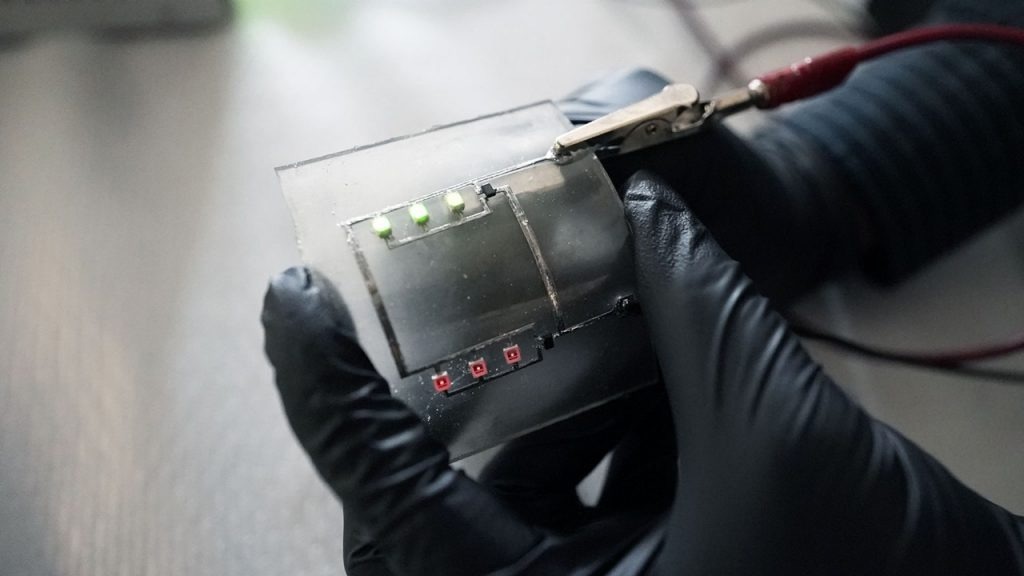Reviewed by Lexie CornerJun 3 2025
A recent study published in Advanced Materials by two research teams at Virginia Tech presents a recyclable material that could help make electronic devices easier to disassemble and reuse.
 The recyclable circuit was created by teams from the Department of Mechanical Engineering and the Department of Chemistry. Image Credit: Alex Parrish for Virginia Tech
The recyclable circuit was created by teams from the Department of Mechanical Engineering and the Department of Chemistry. Image Credit: Alex Parrish for Virginia Tech
Frequent upgrades and breakdowns of cellphones, tablets, laptops, and appliances contribute to a growing volume of discarded electronics. This waste stream is commonly referred to as e-waste.
According to a 2024 United Nations study, global e-waste has nearly doubled over the past 12 years, from 34 billion to 62 billion kilograms. This is roughly equivalent to 1.55 million shipping trucks. The total is projected to reach 82 billion kilograms by 2030.
Only about 13.8 billion kilograms, or approximately 20 % of the current total, are expected to be recycled. That percentage has remained largely unchanged in recent years.
In short, more devices are being discarded, while recycling efforts are not keeping pace.
Chemistry and Engineering Have an Answer
Michael Bartlett, associate professor of mechanical engineering, and Josh Worch, assistant professor of chemistry, collaborated on the development of a new class of circuit materials. Although they come from different disciplinary backgrounds, they worked together on this project.
The circuits, developed by a team of postdoctoral and graduate researchers - including Dong Hae Ho, Meng Jiang, and Ravi Tutika - are designed to be recyclable, electrically conductive, reconfigurable, and capable of self-repair after damage. They also maintain the strength and durability typically found in conventional circuit board plastics, which are not often combined in a single material.
The base of the new material is a vitrimer, a dynamic polymer that can be reshaped and recycled. This polymer is combined with droplets of liquid metal, which serve as the conductive element, similar to how traditional circuits use rigid metals.
This approach differs from earlier methods used to create recyclable or flexible electronics. By combining adaptable polymers with electrically conductive liquid metals, the resulting circuits can endure a range of mechanical and environmental challenges.
Our material is unlike conventional electronic composites. The circuit boards are remarkably resilient and functional. Even under mechanical deformation or damage, they still work.
Michael Bartlett, Associate Professor, Mechanical Engineering, Virginia Tech
A Second Life
Recycling conventional circuit boards involves multiple energy-intensive steps and still produces a significant amount of waste. In the process, valuable metal components - worth billions of dollars - are often lost.
In contrast, the team’s circuit board can be recycled using simpler methods and offers greater flexibility in how the material is recovered.
Traditional circuit boards are made from permanent thermosets that are incredibly difficult to recycle. Here, our dynamic composite material can be healed or reshaped if damaged by applying heat, and the electrical performance will not suffer. Modern circuit boards simply cannot do this.
Josh Worch, Assistant Professor, Chemistry, Virginia Tech
At the end of their useful life, vitrimer circuit boards can be dismantled through alkaline hydrolysis. This process allows for the recovery of key components, such as liquid metal and LEDs. Ongoing research aims to develop a fully closed-loop system in which all conductive composite materials can be reused.
Although it may not be possible to prevent the continued disposal of electronic devices by consumers, this work represents a step toward reducing the amount of electronics that end up in landfills.
The study was supported by Virginia Tech's Institute for Critical Technology and Applied Science and by Bartlett's National Science Foundation CAREER award.
Journal Reference:
Ho, D. H., et al. (2025) Liquid Metal‐Vitrimer Conductive Composite for Recyclable and Resilient Electronics. Advanced Materials. doi.org/10.1002/adma.202501341.